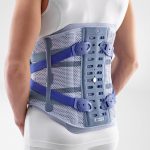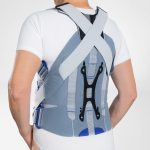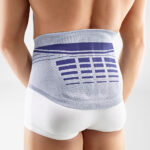The spine is the central support structure of the body, responsible for posture, movement, and protecting the spinal cord. Any damage or misalignment can lead to discomfort, pain, and even long-term health issues. In our daily lives, where sedentary lifestyles and poor posture are common, taking care of our spinal health has become more important than ever.
Back braces are designed to provide support, alleviate pain, and correct posture. By redistributing the weight and pressure on the spine, back braces help in maintaining proper spinal alignment and reducing the risk of injuries. Whether it’s for recovery from a spinal condition, injury prevention, or simply improving posture, back brace support can be a valuable ally in maintaining a healthy spine.
Back Brace Support: The Backbone of Spinal Health
Back brace support plays a multifaceted role in promoting spinal health. By offering support and stabilization, providing pain relief, and aiding in posture improvement, back braces are an essential tool for individuals looking to maintain or improve their spinal health.
Support and Stabilization
One of the primary functions of back braces is to provide support and stabilization to the spine. This is particularly important for individuals who have experienced injuries or are recovering from surgery. By limiting the range of motion and providing a stable framework, back braces help in preventing further strain on the spine. This support is crucial for the healing process, as it allows the spine to maintain its natural alignment and reduces the risk of re-injury.
Pain Relief and Posture Improvement
Back braces are also effective in providing pain relief. By supporting the spine and reducing pressure on the affected areas, these devices can alleviate discomfort and help individuals manage chronic pain conditions. Moreover, back braces can aid in posture improvement. Many people develop poor posture habits due to prolonged sitting or standing, which can lead to spinal misalignment and pain. Wearing a back brace encourages the body to maintain a more upright and ergonomically correct posture, reducing the stress on the spine and promoting better spinal health.
Prevention of Further Injuries
Preventive care is a key aspect of maintaining spinal health. Back braces can play a significant role in this by preventing further injuries, especially for individuals who engage in activities that put a strain on their back. For example, people who lift heavy objects at work or participate in sports can benefit from wearing a back brace to provide additional support and reduce the risk of strains or sprains. By stabilizing the spine and encouraging proper body mechanics, back braces can be an effective tool in injury prevention.
Types of Back Braces
Back braces come in various types, each designed to cater to specific needs and conditions. Understanding the differences between these types can help individuals choose the right back brace for their requirements.
Rigid Braces

These braces limit the range of motion significantly, which is essential for proper healing in cases of fractures or post-operative care. Rigid braces are often custom-fitted to ensure maximum support and comfort.
One example is the Spinova Immo Plus, a multi-functional brace that stabilizes the lumbar spine with a mobilization function, making it a valuable tool in the treatment of various spinal conditions.
Semi-Rigid Braces

These braces are commonly used for conditions like moderate back pain, herniated discs, or mild spinal instability. They can be adjustable, allowing for a customized fit and level of support.
Examples of semi-rigid braces include the SofTec Dorso, which provides targeted support for the thoracic and lumbar spine, and the SacroLoc, designed specifically for the sacroiliac joint, offering both stabilization and pain relief.
Soft Braces

Soft braces can help improve posture and provide relief from discomfort by applying light pressure and warmth to the affected area. These braces are often off-the-shelf and come in various sizes.
Two popular examples of soft braces are the LumboTrain and LumboLoc, both designed to offer support and relief for the lumbar region. LumboTrain is known for its massaging effect that can help reduce pain, while LumboLoc provides targeted support to stabilize the lower back.
Custom-Fitted vs. Off-the-Shelf
Back braces can be custom-fitted or off-the-shelf.
Custom-fitted braces are tailored to an individual’s specific measurements and needs, providing a precise fit and targeted support. These are often recommended for severe conditions or after surgery.
Off-the-shelf braces, on the other hand, come in standard sizes and are more readily available. They are suitable for less severe conditions or temporary use. While they may not offer the same level of customization as custom-fitted braces, off-the-shelf options can still provide effective support and relief for many individuals.
If you’re considering a back brace, Care-Med offers professional custom fitting services to ensure you get the best support for your needs.
Book an appointment with Care-Med today for a personalized fitting.
Choosing the Right Back Brace
Selecting the appropriate back brace is crucial for effective support and comfort.
1. Assess Your Needs
The first step in choosing the right back brace is to assess your specific needs. Consider the reason for wearing a back brace, whether it’s for pain relief, posture correction, injury prevention, or post-surgical support. Understanding the underlying condition or purpose will help guide your choice of the type of back brace that is most suitable for your situation.
2. Consulting with Healthcare Professionals
Before making a decision, it’s important to consult with healthcare professionals, such as a physician, physical therapist, or orthotist. They can provide a professional assessment of your condition and recommend the type of back brace that would be most effective. They can also provide guidance on how to properly use and wear the back brace for optimal results.
Factors to Consider
When choosing a back brace, there are several factors to consider to ensure that it meets your needs:
- Comfort: The back brace should be comfortable to wear for extended periods. Look for materials that are breathable and soft against the skin to avoid irritation.
- Fit: A proper fit is essential for the back brace to be effective. It should be snug enough to provide support but not so tight that it restricts movement or circulation. Adjustable straps or closures can help achieve a better fit.
- Level of Support: Consider the level of support you need. Rigid braces offer the highest level of support, while soft braces provide more flexibility. The severity of your condition and your daily activities will determine the level of support required.
- Durability: Choose a back brace that is durable and able to withstand regular use, especially if you’ll be wearing it frequently.
- Ease of Use: The back brace should be easy to put on and take off, especially if you’ll be doing it yourself.
Effective Use of Back Braces
To ensure that you get the most benefit from your back brace, it’s important to use it correctly. Proper usage is crucial not only for the effectiveness of the brace but also for your comfort and safety. It involves understanding when and how to wear the brace, adhering to the prescribed duration of use, and integrating it appropriately with other aspects of your spinal care routine.
Proper Wearing and Fitting
- Follow Instructions: Always follow the manufacturer’s instructions or your healthcare provider’s recommendations for wearing the back brace.
- Ensure Proper Fit: Make sure the back brace fits snugly but comfortably. It should provide support without causing discomfort or restricting movement excessively.
- Adjust as Needed: If your back brace has adjustable straps or closures, use them to fine-tune the fit. The brace should feel supportive but not overly tight.
Duration and Frequency of Use
- Follow Guidelines: Your healthcare provider will advise you on how long and how often you should wear your back brace. It’s important to follow these guidelines to ensure effective treatment.
- Gradual Increase: If you’re new to wearing a back brace, you may need to gradually increase the duration of use to allow your body to adjust.
- Avoid Overuse: Wearing a back brace for longer than recommended can lead to muscle weakness. Ensure you’re not becoming overly reliant on the brace.
Integrating with Other Treatments
- Combine with Exercise: Back braces are often most effective when used in conjunction with a physical therapy or exercise program. Strengthening the muscles around the spine can provide additional support and aid in recovery.
- Consider Lifestyle Changes: Incorporate ergonomic adjustments in your daily activities, such as using a supportive chair and maintaining good posture, to complement the use of a back brace.
- Regular Check-ups: Regularly consult with your healthcare provider to assess your progress and make any necessary adjustments to your treatment plan.
Maintaining Your Back Brace
Proper maintenance of your back brace is essential to ensure its longevity and effectiveness. A well-cared-for brace not only lasts longer but also provides consistent support and comfort throughout its use.
Regular cleaning, proper storage, and routine inspections are key components of maintaining your back brace. By taking the time to care for your brace, you can ensure that it remains in optimal condition, ready to provide the support you need for your spinal health.
Cleaning and Care
- Follow Manufacturer’s Instructions: Always refer to the care instructions provided by the manufacturer. Different materials may require different cleaning methods.
- Regular Cleaning: Clean your back brace regularly to remove sweat, dirt, and bacteria. For most braces, a gentle wash with mild soap and warm water will suffice.
- Air Dry: After washing, allow the brace to air dry completely before wearing it again. Avoid using a dryer or exposing the brace to direct heat, as this can damage the materials.
- Use a Damp Cloth: For quick clean-ups or for braces that cannot be fully submerged in water, use a damp cloth to wipe down the brace.
Regular Inspection for Wear and Tear
- Check for Damage: Regularly inspect your back brace for signs of wear and tear, such as frayed straps, loose closures, or cracks in rigid components.
- Monitor for Fit: Pay attention to any changes in the fit of the brace. Over time, braces may stretch or deform, which can reduce their effectiveness.
- Replace as Needed: If you notice significant wear or damage, or if the brace no longer fits properly, it may be time to replace it. Continuing to use a worn-out brace can compromise its support and effectiveness.
Prioritizing Spinal Health
Back brace support plays a crucial role in maintaining and improving spinal health. Whether it’s for recovery from an injury, alleviating pain, or correcting posture, the right back brace can provide essential support and stabilization to the spine. By understanding the different types of back braces available and choosing one that fits your specific needs, you can effectively manage and prevent spinal issues.
It’s important to remember that while back braces are a valuable tool, they should be used as part of a comprehensive approach to spinal health. This includes regular exercise, maintaining good posture, and seeking professional advice when needed. By prioritizing your spinal health and using back brace support wisely, you can enjoy a more active, pain-free life and protect your spine for years to come.
Share This Story, Choose Your Platform!
Table of Contents
We specialize in orthotics, body braces, and compression wear tailored to your unique needs in Toronto. Reach out to us at info@caremed.care or call 416-782-5353 to book your fitting and consultation.
Experience the difference of customized solutions designed just for you.











